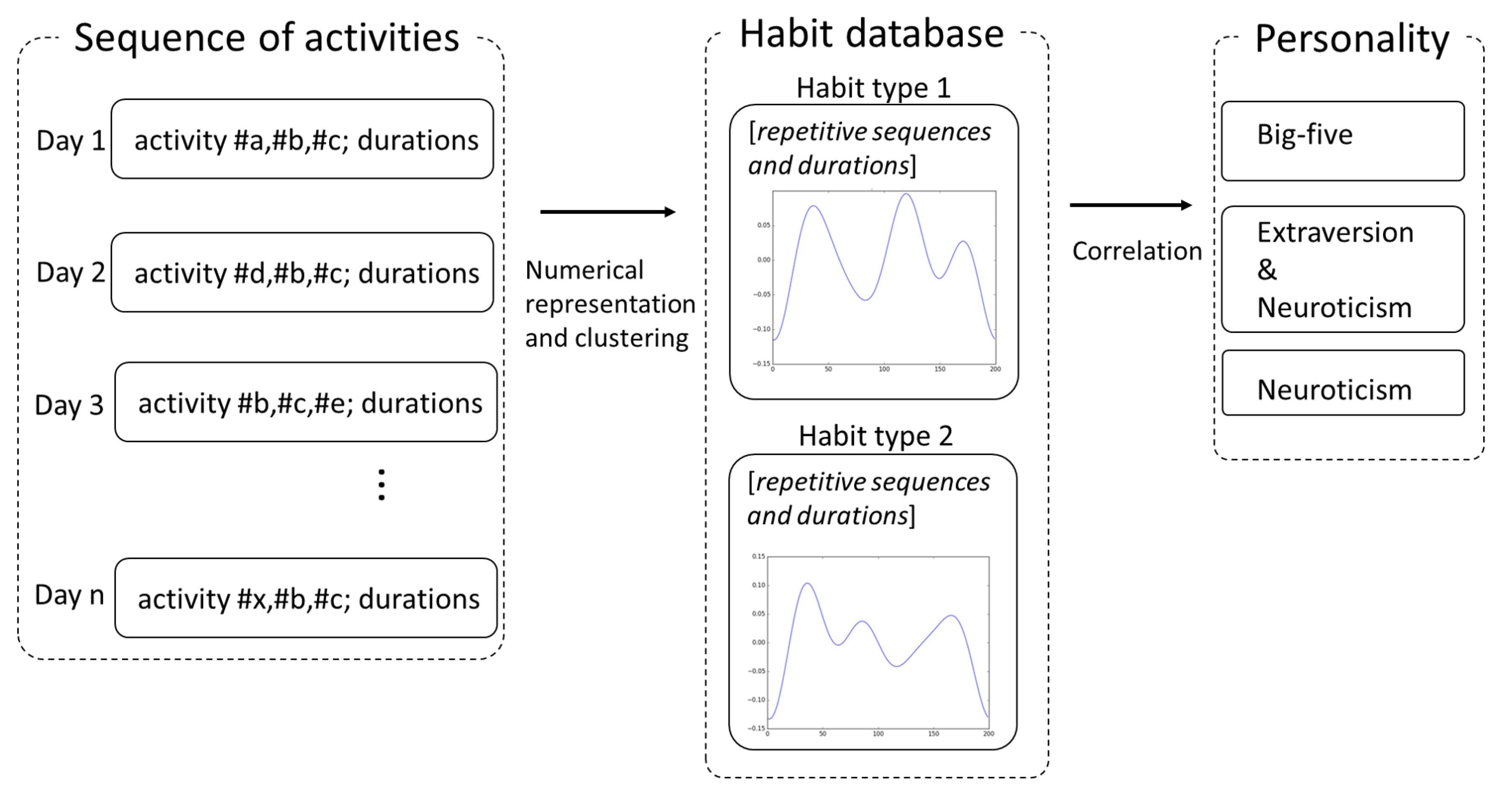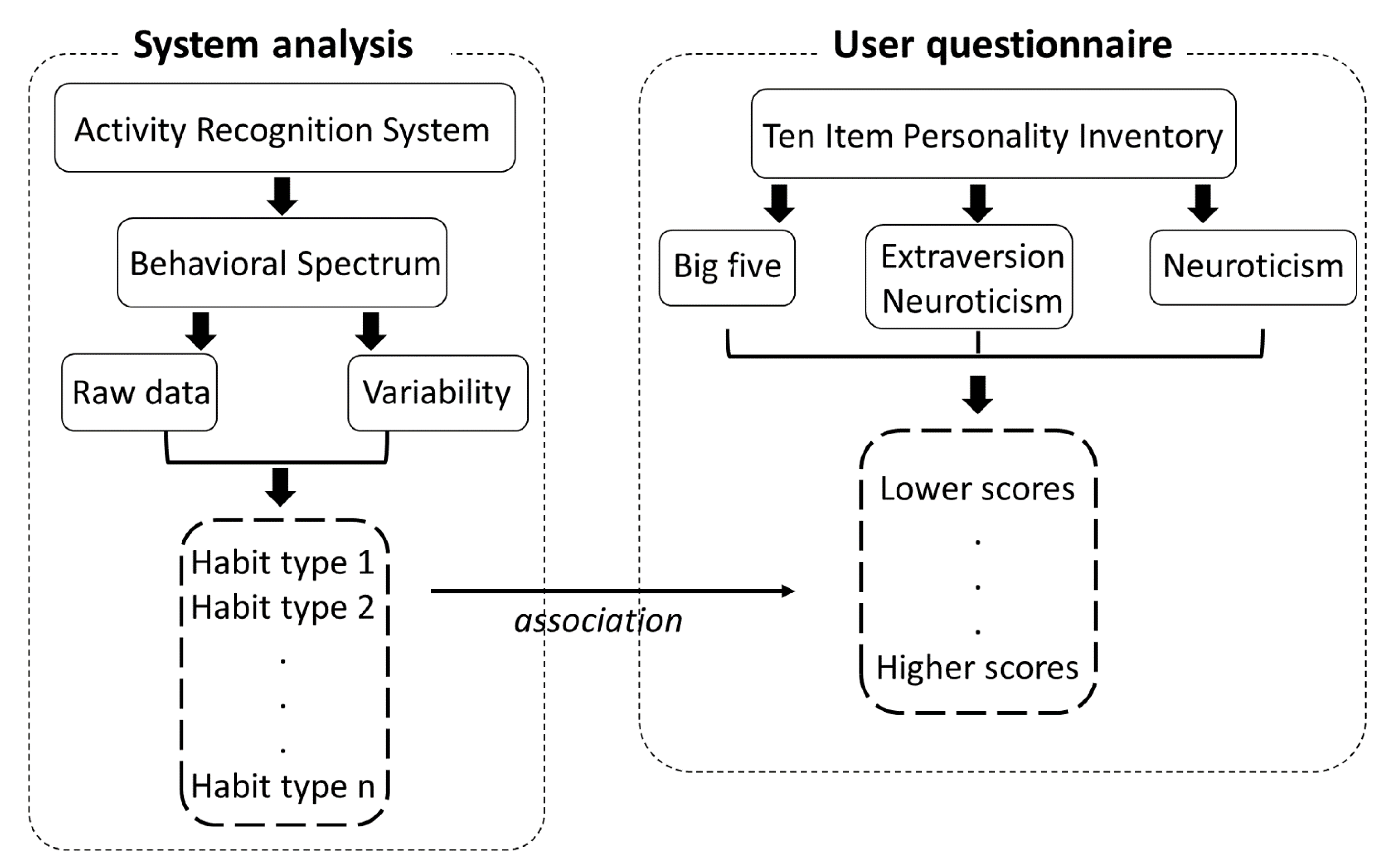Finding Characteristics of Users in Sensory Information: From Activities to Personality Traits
Abstract
1. Introduction
1.1. Personality Trait Computation
1.2. Contributions and Paper Overview
2. Habit Assessment System
2.1. Habit Analysis
2.2. Clustering Behavioral Spectrums to Find User Habits
3. Correlation with the User Personality Trait
3.1. System Analysis
3.2. Comparison of User Questionnaire Scores
3.3. Dataset Description
4. Correlation Results between Personality Scores and Activity Series
4.1. Clustering Results
4.2. Personality Trait Identification Results
5. Discussion and Conclusions
Author Contributions
Funding
Conflicts of Interest
References
- Allport, G.W.; Ross, J.M. Personal religious orientation and prejudice. J. Personal. Soc. Psychol. 1967, 5, 432. [Google Scholar] [CrossRef]
- Eysenck, H. Student selection by means of psychological tests - critical survey. Br. J. Educ. Psychol. 1947, 17, 20–39. [Google Scholar] [CrossRef] [PubMed]
- Eysenck, H.J.; Eysenck, S.B.G. Manual of the Eysenck Personality Inventory; University of London Press London: London, UK, 1964. [Google Scholar]
- Eysenck, H.J.; Eysenck, S.B.G. Manual of the Eysenck Personality Questionnaire (Junior and Adult); Hodder and Stoughton: London, UK, 1975. [Google Scholar]
- Digman, J.M. Personality structure: Emergence of the five-factor model. Ann. Rev. Psychol. 1990, 41, 417–440. [Google Scholar] [CrossRef]
- Vinciarelli, A.; Mohammadi, G. A survey of personality computing. IEEE Trans. Affect. Comput. 2014, 5, 273–291. [Google Scholar] [CrossRef]
- Dotti, D.; Popa, M.; Asteriadis, S. Behavior and Personality Analysis in a nonsocial context Dataset. In Proceedings of the 2018 IEEE/CVF Conference on Computer Vision and Pattern Recognition Workshops, Salt Lake City, UT, USA, 18–22 June 2018; pp. 2354–2362. [Google Scholar]
- Donnellan, M.B.; Robins, R.W. Resilient, overcontrolled, and undercontrolled personality types: Issues and controversies. Soc. Personal. Psychol. Compass. 2010, 4, 1070–1083. [Google Scholar] [CrossRef]
- Berry, J.W.; Elliott, T.R.; Rivera, P. Resilient, undercontrolled, and overcontrolled personality prototypes among persons with spinal cord injury. J. Personal. Assess. 2007, 89, 292–302. [Google Scholar] [CrossRef]
- Card, S.K. The Psychology of Human-Computer Interaction; CRC Press: Boca Raton, FL, USA, 2017. [Google Scholar]
- Celiktutan, O.; Gunes, H. Automatic prediction of impressions in time and across varying context: Personality, attractiveness and likeability. IEEE Trans. Affect. Comput. 2017, 8, 29–42. [Google Scholar] [CrossRef]
- Walters, M.L.; Dautenhahn, K.; Te Boekhorst, R.; Koay, K.L.; Kaouri, C.; Woods, S.; Nehaniv, C.; Lee, D.; Werry, I. The influence of subjects’ personality traits on personal spatial zones in a human-robot interaction experiment. In Proceedings of the IEEE International Workshop on Robot and Human Interactive Communication, Stresa, Italy, 25–26 July 2005; pp. 347–352. [Google Scholar]
- Pianesi, F.; Mana, N.; Cappelletti, A.; Lepri, B.; Zancanaro, M. Multimodal recognition of personality traits in social interactions. In Proceedings of the 10th International Conference on Multimodal Interfaces, Chania, Crete, Greece, 20–22 October 2008; pp. 53–60. [Google Scholar]
- Saez, Y.; Navarro, C.; Mochon, A.; Isasi, P. A System for Personality and Happiness Detection. IJIMAI 2014, 2, 7–15. [Google Scholar] [CrossRef]
- Chittaranjan, G.; Blom, J.; Gatica-Perez, D. Mining large-scale smartphone data for personality studies. Pers. Ubiquitous Comput. 2013, 17, 433–450. [Google Scholar] [CrossRef]
- Chittaranjan, G.; Blom, J.; Gatica-Perez, D. Who’s who with big-five: Analyzing and classifying personality traits with smartphones. In Proceedings of the 15th Annual International Symposium on Wearable Computers, San Francisco, CA, USA, 12–15 June 2011; pp. 29–36. [Google Scholar]
- Amichai-Hamburger, Y.; Wainapel, G.; Fox, S. “On the Internet no one knows I’m an introvert”: Extroversion, neuroticism, and Internet interaction. Cyberpsychol. Behav. 2002, 5, 125–128. [Google Scholar] [CrossRef]
- Gosling, S.D.; Augustine, A.A.; Vazire, S.; Holtzman, N.; Gaddis, S. Manifestations of personality in online social networks: Self-reported Facebook-related behaviors and observable profile information. Cyberpsychol. Behav. Soc. Netw. 2011, 14, 483–488. [Google Scholar] [CrossRef] [PubMed]
- Hwangbo, H.; Yoon, S.H.; Jin, B.S.; Han, Y.S.; Ji, Y.G. A study of pointing performance of elderly users on smartphones. Int. J. Hum.-Comput. Interact. 2013, 29, 604–618. [Google Scholar] [CrossRef]
- Melo, N.; Lee, J. User Activity Aware Support System Using Activity Frame. In Proceedings of the 2nd Workshop on Behavior Adaptation, Interaction and Learning for Assistive Robotics, A full-day workshop hosted at IEEE RO-MAN 2017, Lisbon, Portugal, 28 August–1 September 2017; pp. 1–6. [Google Scholar]
- Liu, L.; Cheng, L.; Liu, Y.; Jia, Y.; Rosenblum, D.S. Recognizing complex activities by a probabilistic interval-based model. In Proceedings of the Thirtieth AAAI Conference on Artificial Intelligence, Phoenix, AZ, USA, 12–17 February 2016. [Google Scholar]
- Liu, Y.; Nie, L.; Han, L.; Zhang, L.; Rosenblum, D.S. Action2Activity: recognizing complex activities from sensor data. In Proceedings of the Twenty-Fourth International Joint Conference on Artificial Intelligence, Buenos Aires, Argentina, 25–31 July 2015. [Google Scholar]
- Liu, Y.; Nie, L.; Liu, L.; Rosenblum, D.S. From action to activity: sensor-based activity recognition. Neurocomputing 2016, 181, 108–115. [Google Scholar] [CrossRef]
- Lu, Y.; Wei, Y.; Liu, L.; Zhong, J.; Sun, L.; Liu, Y. Towards unsupervised physical activity recognition using smartphone accelerometers. Multimed. Tools Appl. 2017, 76, 10701–10719. [Google Scholar] [CrossRef]
- Sousa Lima, W.; Souto, E.; El-Khatib, K.; Jalali, R.; Gama, J. Human Activity Recognition Using Inertial Sensors in a Smartphone: An Overview. Sensors 2019, 19, 3213. [Google Scholar] [CrossRef]
- Tamamori, A.; Hayashi, T.; Toda, T.; Takeda, K. An investigation of recurrent neural network for daily activity recognition using multi-modal signals. In Proceedings of the 2017 Asia-Pacific Signal and Information Processing Association Annual Summit and Conference (APSIPA ASC), Kuala Lumpur, Malaysia, 12–15 December 2017; pp. 1334–1340. [Google Scholar]
- Singh, D.; Merdivan, E.; Psychoula, I.; Kropf, J.; Hanke, S.; Geist, M.; Holzinger, A. Human activity recognition using recurrent neural networks. In Proceedings of the International Cross-Domain Conference for Machine Learning and Knowledge Extraction, Reggio, Italy, 29 August–1 September 2017; pp. 267–274. [Google Scholar]
- Wang, J.; Chen, Y.; Hao, S.; Peng, X.; Hu, L. Deep learning for sensor-based activity recognition: A survey. Pattern Recognit. Lett. 2019, 119, 3–11. [Google Scholar] [CrossRef]
- Melo, N.; Lee, J.; Suzuki, R. Identification of the User’s Habits based on Activity Information. In Proceedings of the 2018 IEEE/RSJ International Conference on Intelligent Robots and Systems (IROS), Madrid, Spain, 1–5 October 2018; pp. 1–6. [Google Scholar]
- Ye, J.; Dobson, S.; McKeever, S. A review of situation identification techniques in pervasive computing. Pervasive Mob. Comput. 2012, 8, 36–66. [Google Scholar] [CrossRef]
- Stefanov, D.H.; Bien, Z.; Bang, W.C. The smart house for older persons and persons with physical disabilities: Structure, technology arrangements, and perspectives. IEEE Trans. Neural Syst. Rehabil. Eng. 2004, 12, 228–250. [Google Scholar] [CrossRef]
- Lee, J.; Melo, N. Habit representation based on activity recognition. Sensors 2020. submitted. [Google Scholar]
- Melo, N.; Lee, J. Environment Aware ADL Recognition System based on Decision Tree and Activity Frame. Paladyn J. Behav. Rob. 2018, 9, 155–167. [Google Scholar] [CrossRef]
- Melo, N.; Lee, J. Design of a smart support system architecture focusing on the user activity. In Proceedings of the 28th IEEE International Symposium on Micro-NanoMechatronics and Human Science (MHS), Nagoya, Japan, 3–6 December 2017; pp. 1–7. [Google Scholar]
- MacKay, D.J. Information Theory, Inference and Learning Algorithms; Cambridge University Press: Cambridge, UK, 2003. [Google Scholar]
- Jain, A.K. Data clustering: 50 years beyond K-means. Pattern Recognit. Lett. 2010, 31, 651–666. [Google Scholar] [CrossRef]
- Eysenck, H.J. Biological dimensions of personality. In Handbook of Personality: Theory and Research; The Guilford Press: New York, NY, USA, 1990; pp. 244–276. [Google Scholar]
- Kodinariya, T.M.; Makwana, P.R. Review on determining number of Cluster in K-Means Clustering. Int. J. Adv. Res. Comput. Sci. Manag. Stud. 2013, 1, 90–95. [Google Scholar]






| ALL Dataset | |||
|---|---|---|---|
| Number of Clusters | Variance Explained (%) | ||
| All Five Traits | Extroversion Neuroticism | Neuroticism | |
| 1 | 0.2056 | 0.383271 | 0.640277 |
| 2 | 0.470641 | 0.578762 | 0.821736 |
| 3 | 0.567452 | 0.700684 | 0.911073 |
| 4 | 0.649912 | 0.784866 | 0.951275 |
| 5 | 0.715607 | 0.845282 | 0.975167 |
| 6 | 0.769358 | 0.88677 | 0.987584 |
| 7 | 0.809432 | 0.920082 | 0.995973 |
| 8 | 0.844376 | 0.942652 | 1 |
| 9 | 0.873644 | 0.959033 | 1 |
| 10 | 0.899276 | 0.971873 | 1 |
| 11 | 0.92267 | 0.980246 | 1 |
| 12 | 0.941895 | 0.986584 | 1 |
| HS Dataset | |||
|---|---|---|---|
| No. of Clusters | Variance Explained | ||
| All Traits | Extroversion Neuroticism | Neuroticism | |
| 1 | 0.326387 | 0.488978 | 0.573366 |
| 2 | 0.540396 | 0.697463 | 0.844636 |
| 3 | 0.679401 | 0.833466 | 0.95561 |
| 4 | 0.79117 | 0.910873 | 0.985203 |
| 5 | 0.872182 | 0.943198 | 1 |
| 6 | 0.92555 | 0.965009 | 1 |
| 7 | 0.960495 | 0.981561 | 1 |
| 8 | 0.981702 | 0.992478 | 1 |
| 9 | 0.991811 | 0.998868 | 1 |
| 10 | 0.997622 | 1 | 1 |
| Personality Types | Association Rate; Correlation Coefficient | |
|---|---|---|
| Personality trait features | Behavioral Spectrum raw data | Behavioral Spectrum variability |
| All five traits | 0.64; 0.34 (p = 0.072) | 0.60; 0.34 (p = 0.072) |
| Extroversion and Neuroticism | 0.57; 0.34 (p = 0.072) | 0.67; 0.34 (p = 0.072) |
| Neuroticism | 0.53; 0.25 (p = 0.184) | 0.53; 0.25 (p = 0.184) |
| Personality Types | Association Rate; Correlation Coefficient | |
|---|---|---|
| Personality trait features | Behavioral Spectrum raw data | Behavioral Spectrum variability |
| All five traits | 0.75; 0.25 (p = 0.433) | 0.58; 0.35 (p = 0.259) |
| Extroversion and Neuroticism | 0.58; 0.47 (p = 0.115) | 0.58; 0.17 (p = 0.599) |
| Neuroticism | 0.50; 0.44 (p = 0.144) | 0.50; 0.66 (p = 0.017) |
| Personality Types | Association Rate; Correlation Coefficient | |
|---|---|---|
| Personality trait features | Behavioral Spectrum raw data | Behavioral Spectrum variability |
| All five traits | 0.83; 0.42 (p = 0.166) | 0.83; 0.42 (p = 0.166) |
| Extroversion and Neuroticism | 0.50; 0.35 (p = 0.254) | 0.50; 0.35 (p = 0.254) |
| Neuroticism | 0.58; 0.30 (p = 0.340) | 0.58; 0.30 (p = 0.340) |
| Personality Types | Association Rate; Correlation Coefficient | |
|---|---|---|
| Personality trait features | Behavioral Spectrum raw data | Behavioral Spectrum variability |
| All five traits | 0.66; 0.25 (p = 0.433) | 0.58; 0.23 (p = 0.454) |
| extroversion and Neuroticism | 0.66; 0.48 (p = 0.107) | 0.66; 0.31 (p = 0.319) |
| Neuroticism | 0.83; 0.66 (p = 0.017) | 0.83; 0.66 (p = 0.017) |
© 2020 by the authors. Licensee MDPI, Basel, Switzerland. This article is an open access article distributed under the terms and conditions of the Creative Commons Attribution (CC BY) license (http://creativecommons.org/licenses/by/4.0/).
Share and Cite
Lee, J.; Bastos, N. Finding Characteristics of Users in Sensory Information: From Activities to Personality Traits. Sensors 2020, 20, 1383. https://doi.org/10.3390/s20051383
Lee J, Bastos N. Finding Characteristics of Users in Sensory Information: From Activities to Personality Traits. Sensors. 2020; 20(5):1383. https://doi.org/10.3390/s20051383
Chicago/Turabian StyleLee, Jaeryoung, and Nicholas Bastos. 2020. "Finding Characteristics of Users in Sensory Information: From Activities to Personality Traits" Sensors 20, no. 5: 1383. https://doi.org/10.3390/s20051383
APA StyleLee, J., & Bastos, N. (2020). Finding Characteristics of Users in Sensory Information: From Activities to Personality Traits. Sensors, 20(5), 1383. https://doi.org/10.3390/s20051383





